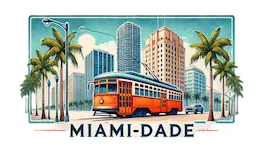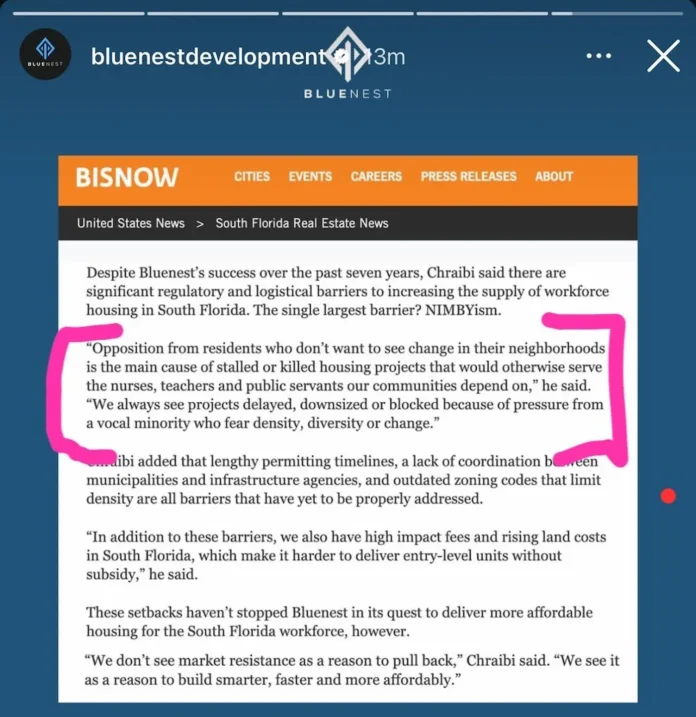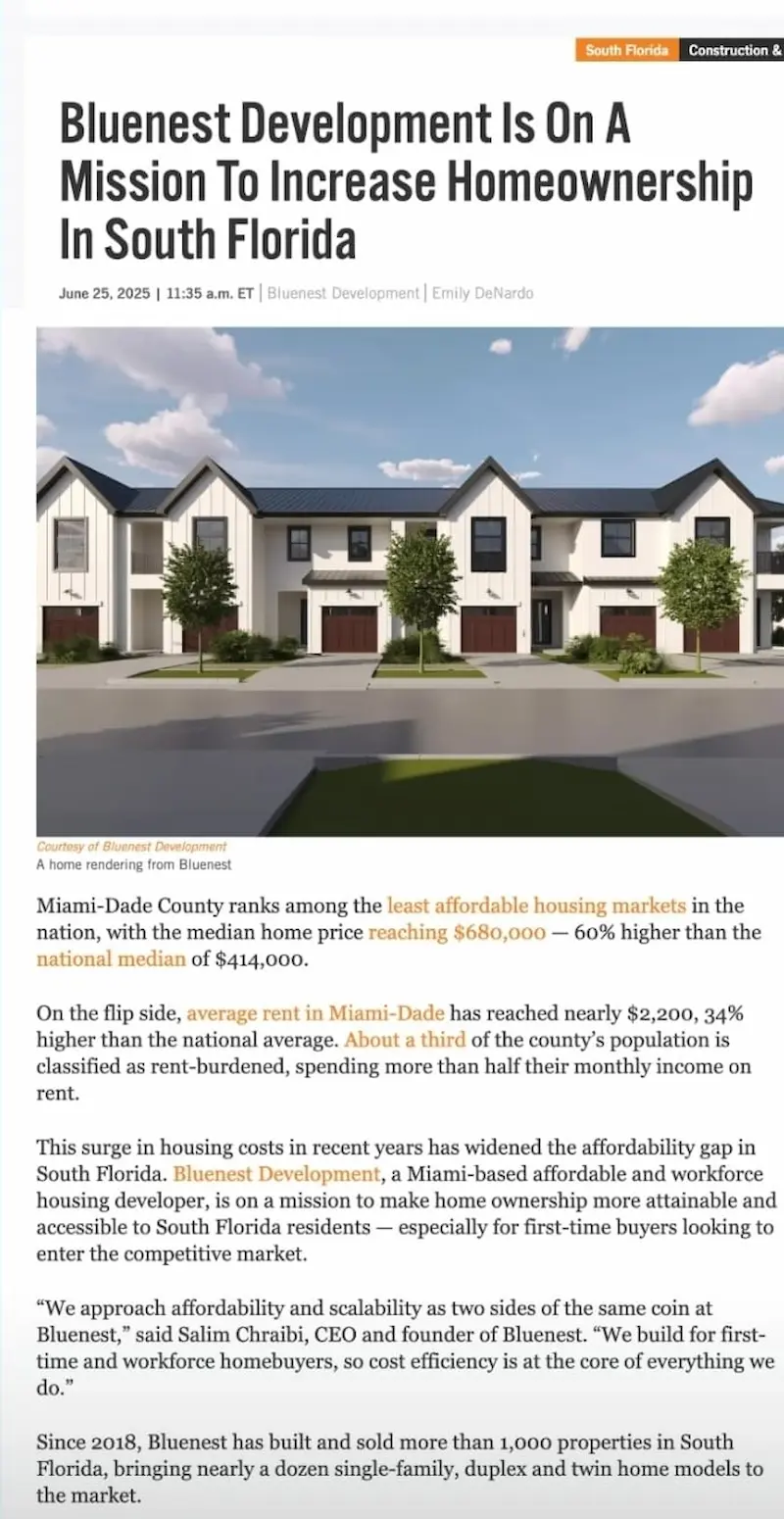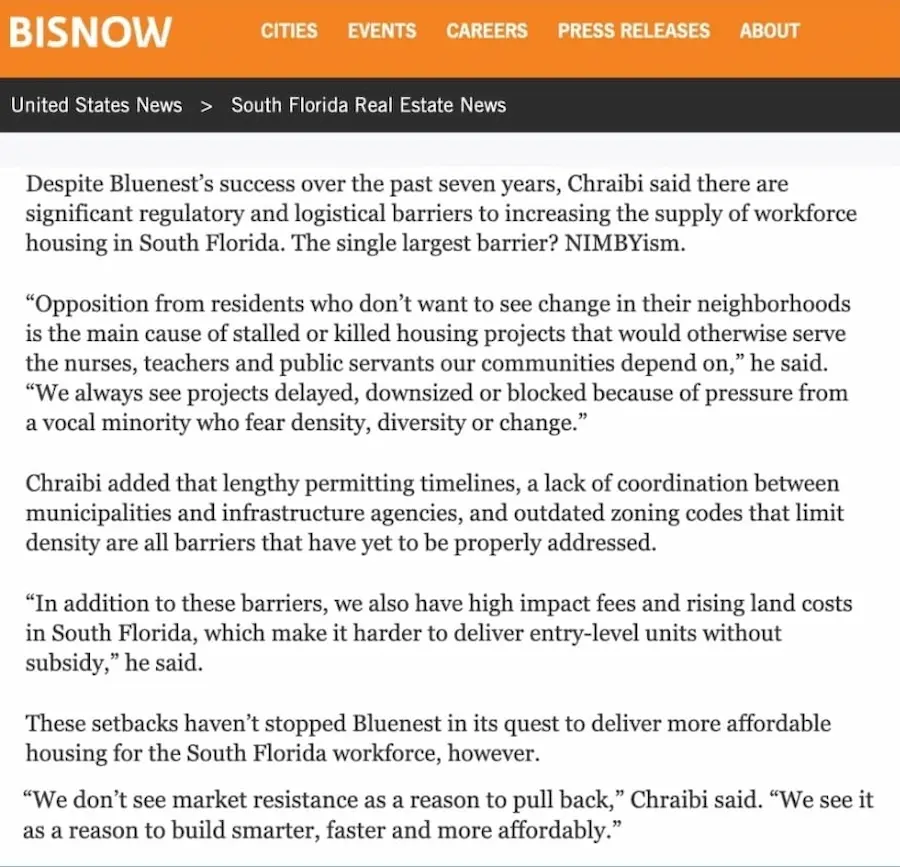|
Getting your Trinity Audio player ready... |
Tabla de Contenido/ Table of Contents
Bluenest: Housing Solution or Threat to Miami-Dade’s Agricultural Heritage? It is the imminent threat to the historic farmlands of Redland and Naranja.
While Bluenest Development launches a media campaign presenting itself as the hero of the housing crisis in South Florida, a parallel reality is emerging from the rural heart of the county: the imminent threat to the historic agricultural lands of Redland and Naranja.
The Corporate Narrative: Promises and Marketing
In recent interviews and promotional articles like the one published by Bisnow on June 25, 2025, Salim Chraibi, CEO of Bluenest, blames residents for opposing urban densification in rural areas. He labels them as a “vocal minority” that fears change, diversity, or density. According to his narrative, the only obstacles to building more homes are the citizens who want to preserve the character of their neighborhoods.
What Bluenest fails to mention in its statements is that its most recent project, which seeks to transform more than 33 acres of protected agricultural land in Naranja into a townhouse complex, requires changing the County’s Comprehensive Development Master Plan (CDMP) and modifying traditional agricultural zoning. This type of change not only goes against current preservation policies but also opens the door to uncontrolled urbanization that could permanently erase one of South Florida’s last green lungs.
The Truth Behind the Discourse
Contrary to the image of benefactors they promote, Bluenest has requested the reclassification of land located outside the Urban Development Boundary (UDB), setting a dangerous precedent. These lands are close to environmentally sensitive areas, habitats of protected species like the Adiantum tenerum fern, and are also within the historically defended agricultural zone by generations of residents and farmers.
The “affordability” argument promoted by Bluenest contradicts the reality of the market: the projects presented by this company are targeted at people earning 80 to 140% of the Area Median Income (AMI), excluding a large portion of the most vulnerable working population. And while they claim to build without subsidies, they have requested regulatory changes that represent indirect subsidies through exceptions, relaxations, and customized land use.
Who Really Benefits?
Bluenest is not a non-profit organization. Like any private company, its goal is to generate profit. The densification model they promote is based on maximizing land occupancy, reducing costs through repetitive designs, and selling properties under complex financing schemes, including second and third mortgages. These practices can lead to over-indebtedness in low-income households seeking their first home.
Meanwhile, residents opposing the Naranja project do so not out of prejudice or fear of change, but out of intergenerational responsibility: they seek to protect a strategic agricultural zone, ecologically fragile, and one that feeds the entire county with local products. This is not NIMBY. It is common sense, a defense of the territory, biodiversity, and a rural lifestyle that is part of Miami-Dade’s historical identity.
The Fight Continues: #SaveRedland
In the face of this threat, citizens, environmentalists, farmers, and community leaders have raised their voices under the #SaveRedland campaign. They denounce the institutional double standard: while the agricultural zone surrounding Mayor Daniella Levine Cava’s property is fervently protected, other equally valuable lands are being put at risk to favor real estate interests.
Today, more than ever, it is time to demand consistency from our officials, to question corporate arguments wrapped in marketing, and to bring a key question to the table: do we want a fully urbanized Miami-Dade, without agricultural reserves or ecological balance?
🎥 VIDEO | “We Are Not the Vocal Minority, We Are the Landowners” – José Debasa Joins the Defense of Redland
In direct response to the promotional article by BlueNest Development, where its CEO Salim Chraibi labels residents opposing the mega urbanization projects as a “vocal minority afraid of diversity, density, and change,” Redland resident José Debasa raises his voice, alongside his wife, with a truth that can no longer be ignored:
🗣️ “We are not a vocal minority, sir. We are taxpayers. We are residents who have been here for over 30 and 50 years. This is not a whim: this is our community, our life.”
In the video, José dismantles BluNest’s propagandistic discourse, showing that the problem is not “affordable” housing or essential workers — but the intensive agricultural re-zoning to insert 13 units per acre in land where only 1 or 2 are currently allowed, without adequate exits, guaranteed drainage, or sufficient infrastructure. Is that responsible development?
🌱 Redland is not empty land. It is history, agriculture, and the county’s green lung. This is not about NIMBY (Not In My Backyard) — it is about protecting the rural and ecological balance of a community that has sustained Miami-Dade for generations.
👉 Share this video. Help us tell BlueNest and the county commissioners: Redland is not for sale! Redland must be defended!
#SaveRedland #RedlandIsLife #NoToRezoning #BluNestDoesNotSpeakForUs #MiamiDadeAgricultural #UnitedResidents #DefendTheCountryside #RedlandNotForSale
📰 Want more news like this?
Visit our homepage to stay up to date with the latest from South Florida and more:













